|
Common Management Practices
Colostrum feeding
|
 |
Colostrum Feeding |
- Colostrum is the first milk secreted after parturition.
- It contains large amount of Gama globulins which are anit-bodies produced by the cow against antigens encounter during her life including those against many disease producing organisms.
- Colostrums is highly fortified source of nutrient having 7 times the protein and twice the total solids of normal milk, thus it gives an early boost in portion and solid intake.
- It contain higher amount of minerals and vitamin A which are essential to combat disease. Ingestion of these through colostrums substantially increases the calf’s survivability.
- Absorption of these antibodies provides the calf with an umbrella of passive immunity.
- Colostrums give a laxative effect which is helpful in expulsion of muconium (first faeces).
- It will be highly useful to feed colostrum in the first 15-30 minutes followed by a second dose in approximately 10-12 hours.
- First ½ hour to 12 hours of life, calf should be given with colostrum of its 5-8 % of body weight. Then 2nd and 3rd day, it should be of 10% of its body weight.
- The excess colostrums can be stored by refrigeration and can be used to other calves or orphan calves.
Composition of Colostrum
Constituents |
Colostrum of cow milk |
Colostrum of buffalo milk |
Normal Milk |
Total solids |
28.30 |
31.0 |
12.86 |
Ash |
1.58 |
0.9 |
0.72 |
Fat |
0.15-1.2 |
4.0 |
4.0 |
Lactose |
2.5 |
2.2 |
4.8 |
Casein |
4.76 |
7.7 |
2.8 |
Albumin |
1.5 |
3.6 |
0.54 |
Globulin |
15.06 |
12.5 |
- |
Total protein |
21.32 |
23.8 |
3.34 |
|
|

| Weaning |
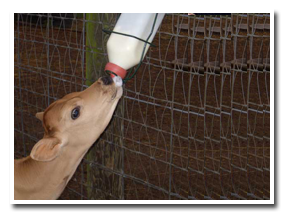 |
Weaning |
- Separation of calf and making independent of its mother for food is known as weaning.
- Now days, early weaning is recommended for better management.
- Under early weaning system, weaned calves housed separately and scientific feeding schedule and managemental practices followed.
- In this method, the cow is not allowed to suckle by its calf after colostrum feeding.
- Instead, the cow is completely milked out and required quantities of whole milk or skim milk are fed to the calf.
- Weaned calves should be trained to drink milk from pails / nipple pail so that feeding management is easier.
- Weaned calves should be weighed every week and the quantity of milk to be fed is calculated accordingly.
|
|

| Identification of farm animals |
- Identification of animals is must, as a requirement in the daily management, to spot and identify a particular animal in a herd/group/flock.
Reasons
- For registration and recording of the parentage in breeding programme / birth
- For individual feeding of animals.
- During milking
- During sale, for participation of animals in the rally, show and exhibition.
- For treating the animal, heat detection etc.
Methods of Identification
- Neck chain/Neck rope
- Ankle band
- Brisket tag
- Tail tag
- Chalk/grease marker
- Black/light coloured paints
- Pictures/sketches
- Photographs
- Ear tattooing
- Ear Notching
- Branding
- Ear tagging
1.Ear tatooing
- It is one of the permanent methods of identification system.
- Instruments Required
- Tattooing forceps, tattoo no/letters
- Tattooing ink/paste
- Procedure
- The required dies (Numbers and letters) assembled in the tattooing forceps.
- Locate the area in the ear to be tattooed. (above the cartilage equidistance between tip and cartilage of the ear).
- Clean the area with alcohol.
- Position the equipment. Check the Number / letter in a piece of paper before applying in the ear.
- Then squeeze the forceps for puncturing properly.
- Rub the tattoo ink / paste on the punctured area.
2.Ear tagging
- Most popular method of identification system.
-
Equipments Required
- Procedure
- Select the tag type (Single piece / Double piece).
- Use the contrasting ink and style based on the skin colour of the animal.
- Invert the ear tag into the appropriate applicator.
- Locate the area in the ear for tagging) (half the way between base and tip of the ear).
- Puncture the ear with applicator if the tags are non-piercing type.
- Apply the ear tag by puncturing the ear with the applicator.
3.Branding
- It is one of the permanent method
-
Hot Iron branding
- A good hot iron branding should be visible and recognizable since it destroys hair follicles located under several layers of the skin and leaved a permanent bald scar on the skin of the animal.
- Required
- Branding irons / Electric branders made up of iron or steel, squeeze chute / Trevice (for restraining)
- Procedure
- Assemble and keep the equipment ready
- Heat the branding iron
- Before branding, restrain the animal
- Check the temperature of branding iron. It should be grey ashes.
- Then press the iron and shake the handle against the skin for fixing the iron properly.
- Time of application usually 3-5 sec.
- The brand marks should be big enough to read identify at a distance and each letter separated 2.5cm to prevent sloughing of the skin.
- Apply an antiseptic for healing of wound.
- Freeze branding
- Application of cold iron to the skin of the animal causes destruction of melanocytes and white hairs grows on the branded area.
- Procedure
- Assemble the necessary cold branders / iron.
- Cool the branding irons in the liquid nitrogen or dry ice
- Before application, restrain the animal
- Clip the area of the branding site, clean and apply alcohol to the clipped area
- Apply the cold branders to the clipped area and apply equal pressure by pressing iron properly and evenly on the skin.
- Time of application 30 sec to 1 min.
4.Ear notching
- Commonly used in pigs and in beef cattle.
- Notching means making a ‘V’ shaped notches at specific areas of the ear with the help of a sharp scissors or pincers.
- For e.g. a notch in lower right ear is no.1. and notch in lower left ear is No.3.
|
|

| Castration |
 |
Castration |
- Making the animal unable to reproduce is generally known as castration.
- In India and other South-East Asian countries bullocks are extensively used for agricultural operations.
- Buffalo is particularly valued as a draught animal in rice growing areas.
- Male cattle and buffaloes meant for work should be castrated.
- Purpose
- To render the animal docile
- To induce faster gain in body weight and to improve the quality of meat.
- To control indiscriminate breeding.
- To prevent certain genital diseases.
- Castration also results in lean and slender neck which facilitates the correct fitness of yoke especially in work cattle.
- Precaution
- Castration should be performed during cold season and strictly avoid rainy season for fear of fly problems.
- Castrated animals should be rested for few days in clean and comfortable pens.
- Optimum Age
- Young animals: within 3 months (Surgical method and elastrator)
- Adult animal: within one year of age (Closed method – Burdizzo castrators)
Methods
1. burdizzo method
- It is also known as bloodless castration. The Burdizzo castrator is used to crush the spermatic cord and thus stopping the blood to the testes.
- This results in atrophy of the testes and stoppage of spermatozoa production.
- After casting, secure the animal. Move the spermatic cord to the side of the scrotum and then clamp the Burdizzo at about 3-5 cm above the testicles and it is held for a few seconds.
- Then repeat this operation on the same cord at a location about 1cm below the first one. This method is safe, quick and less chance of getting infection.
2.Open or surgical method
- Scrotum is opened and testicles are removed, aseptically and the wound is treated with antiseptics.
- In young bulls the cord may be cut as savagely off but in the case of mature bulls the cord should be twisted before severing it.
3. Rubber ring or elastrator method
- A strong and tight rubber ring placed around the cord at an early age of calf.
- This creates constant pressure and the testicles are atrophied and absorbed and the ring drops down.
- Elastrator rings are very painful to the animal and so it is not usually recommended. Optimum age: below 3 months.
|
|

| Disbudding |
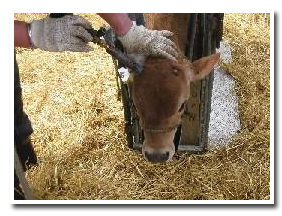 |
Disbudding |
- Disbudding means arresting the horn growth at an early age, when the horn root is in the bud stage.
- Horn serves no useful purpose.
Purpose
- Dehorned animals need less space in the sheds.
- Cattle with horns inflict bruises on each other that may result in heavy economic losses.
- Horned animals are a danger to the operator.
- Dehorned animals can be handled more easily.
- Prevents the occurrence of horn cancer.
Optimum Age
Methods
Hot iron method
- A specially designed electric dehorner is used for this purpose. This is bloodless method it may be used at any season.
- The rod heated with electricity has an automatic control that maintain the temperature at about 10000 F, applying it to the horn bud for l0 seconds is sufficient to destroy the horn tissue.
2. Elastrator
- A specially made thick rubber ring applied to the base of the horn.
- The rubber band shuts off circulation and the horn gradually comes off. Small buds drop off in 3 to 6 weeks and large horns may take even 2 months.
- It is a painful method and this method is used on cattle when the horn length is about 5-10 cm.
3. Chemical method
- Caustic potash or caustic soda is the common chemical used for dehorning.
- These are available in the form of paste or solution.
- Clip the hair around the horn buds and surrounding area, a ring of Vaseline to protect the eyes against chemicals.
- Rub the chemical over the buds until bleeding occurs.
4. Dehorning saw or clippers
- When older cattle are to be dehorned a specially designed clippers or saw are used.
- A considerable amount of bleeding may follow the operations.
- To prevent the bleeding the main horn artery should be tied off with a cotton or silk thread.
- This may be done by sliding a sewing needle under the artery to pull the thread in place before tying.
- It is necessary when sawing or clipping the horns, to take about half an inch of skin in order to get at the horn roots.
|
|

| Extra teat removal |
- Normal udder should have four severely placed teats of uniform size. But animals with one and even two extra teats are also seen. Such extra teats may be blind or leaky.
- It should be removed before the calf attains 6 months of age.
- After controlling the calf, the region is thoroughly cleaned and disinfected with Tincture iodine and mark extra teats before removal. These teats are clipped off with scissors.
- Some more tincture is applied after finishing the process. In the older heifer, suture is put in order to arrest bleeding.
|
|

| Dentition and Ageing of Cattle and Buffalo |
Ageing of animals is important for the following reasons,
- To issue soundness certificate
- To select and purchase livestock
- To know the breeding status of the animal
- To estimate the value of the animal
The age of an animal can be estimated from
- The date of birth available in registers or by
- Dentition
- Horn rings
- Number of young one produced by the animal.
Cattle - Dentition
- Temporary dentition: 0/4 0/0 3/3 0/0
- Permanent dentition: 0/4 0/0 3/3 3/3
- At birth: Calves are usually found to have their 8 incisors and 3 pre molars of the temporary dentition easily palpable below the gums.
- At 1 month: 8 temporary incisors have their crowns free from the gums and the teeth are quite prominent and well defined. The three temporary molars are well up and wearing.
- At 6 months: The teeth are well placed in the jaw and are no longer overlapping.
- At 1 year: The most marked change between this time and 6 months of age is the wear of the temporary incisors.
- At 2 years: The first pair of permanent central incisors re¬place the corresponding temporaries and the first and second molars push out the temporaries and cut through the gums.
- At 2 1/2 - 3 years: The second pair of permanent medial incisors replace the corresponding temporaries.
- At 3 - 3 1/2 years: The third pair of permanent lateral inci¬sors replace the corresponding temporaries.
- At 4 years: The last pair of permanent corner incisors replace the corresponding temporaries.
- At 4-5 years: The teeth are slightly worn along their cutting edges, and they occupy a less crowded position.
- At about 6 years: The surface of wear has reached practically half-way across the upper surface of the teeth, and a portion of the root is exposed.
- At 10 years: The greater parts of the crowns have worn from the teeth and only a little cup-shaped piece of enamel remains.
- At about 12 to 14 years: Only the stumps of the teeth remain.
- In horned breeds of cattle a rough estimate of age can usually be made by counting the number of rings round the bases of the horns. The first ring appears at about 2 years and thereafter one ring is added annually.
Type of teeth |
Age of eruption |
1st pair central incisors |
2-2 ½ years |
2nd pair central incisors |
3 years |
3rd pair central incisors |
4 years |
4th pair central incisors |
4 ½ years |
Type of teeth |
Age of eruption |
1st pair molars |
2 years |
2nd pair molars |
2 ½ years |
3rd pair molars |
3 years |
4th pair molars |
3 ½ years |
5th pair molars |
4 years |
6th pair molars |
4½ years |
- Full mouth in country breed - 4 1/2 years.
|
|

| Transport of Cattle and buffalo |
General conditions for transport of animals
- Healthy animals should be transported and a qualified veterinarian should certify it.
- Young animals should be separated from adult animals and advanced pregnant state animals should be separated from other animals.
- When animals are transported from endemic area, necessary permission should be obtained from concerned authorities for proper health condition.
- 14 days prior to transportation necessary vaccination procedure should be completed for the particular livestock.
- During transport all the livestock should be given humane treatment
- Sufficient quantity of feed and fodder should be carried during transport
- The vehicle should be examined for cleanliness, the floor and walls shall be undamaged and should be free from nails and other sharp edges
- The vehicle should be sprayed with disinfectant solution
- Materials for bedding such as straw or hay should be placed on the floor to avoid injury and the bedding should not be less than 5 cm thickness
- Animals during transport should not be tied up at leg.
- Each consignment shall bear a bold red label showing the following particulars
- Number and kind of animals loaded
- Name and address and telephone number of the consignor (sender) and consignee (receiver)
- Quantity of ration to be fed
- Consignee should be informed about the train or vehicle in which the consignment of cattle is sent and its arrival time in advance
- In case of journey for more than 12 hours an attendant should be present at all the time and should ensure the proper conditions are maintained during transport.
- Cattle, sheep and goat should be unloaded by every 8 hours and should be watered. The attendant should not permit the sheep and goat to sit down during transit.
- Apart from the above general condition some species of livestock require specific conditions for transport and it also depends upon the mode of transport.
General conditions for train transport
- Animals shall be transported by passenger trains only. In areas where such trains are not run, the equines may be transported by goods trains provided that special precautions are taken.
- Ordinary Cattle wagon when used for transportation of horses, ponies, mules and donkeys along with their foals, shall carry not more than 6 of these animals on broad gauge, 4 on meter gauge and 3 on narrow gauge. Attendants shall be allowed to travel along with the animals in each wagon.
- In extreme summer, water shall be sprinkled over the wagons by the railway authorities to bring down temperature; ice cubes in specially made containers may be placed inside the wagon if recommended by veterinarian.
- Every wagon shall have 2 attendants if the animals are more than 2 in number.
- Animal shall be loaded parallel to the rails facing each other.
- Material for padding (Kapok) such as paddy straw shall be placed on the floor to avoid injury if an animal lies down. This shall not be less than 6 cm thick.
- Rations for the journey shall be carried in the middle of the wagon.
- To provide adequate ventilation the upper door of one side of the wagon shall be kept open and properly fixed.
- This door of the wagon shall have wire gauge welded to it to prevent burning cylinders from the engine entering the wagon and leading to the outbreak of fire.
- 2 breast bars shall be provided on each side of the wagon one at a height of 60 to 90 cm and other at 100 to 110 cm.
- Valuable animal shall be transported in EH or EHH horse box. These shall be provided by the railways.
General conditions for Sea transport
- All ships detailed for conveying animals shall be inspected for fittings by a board consisting of a marine and a veterinary officer.
- The ship may preferably be of shelter deck type and have ample mechanical ventilation, good drainage and arrangements for exercising the animals.
- Horses may normally be accommodated in a single stalls and mules in pens. Each pen holding 4 to 5 mules.
- Providing portholes and permanent air trunks or electric powers on all decks shall ensure more ventilation. Exhaust fans shall be installed to below out foul air.
- The pens shall be mucked out twice day decks scrubbed once every 24 hours. This shall be done when animals are being exercised.
- All standings shall be towards the ship with heads facing inwards.
- Length between breast rail and back lining shall be 2 metres. Breast rails shall be 1.1 m from the platform.
- Passage between 2 rows of pens should be not less than 1.5 metres.
- Parting boards between pens shall be 3 metres.
- To avoid distress especially during hot weather the ship may sail immediately after embarking.
- Entries (stallions) shall not be kept in same decks.
- Clots and fillies shall be kept on the exposed decks.
- A pharmacy and spare stalls for 5% animals shall be made available.
General conditions for Air transport
- In aircrafts animals are either secured in crates of 2 to 3 horses each or kept tied in pens 4 to 5 to each pen.
- The floors of aircrafts are provided protected by a thick layer of wood shavings and covered with polyethylene sheets. Sides of the body are well padded.
- All animals shall be administrated tranquilizers before loading. If an animal becomes considerable within the aircraft it shall be destroyed.
- All aircraft for transporting animals shall be inspected for fitting etc by a board comprising an air force and veterinary officer.
- Loading shall be effected through ramps or lifts.
- An attendant shall accompany the animal consignment.
- A veterinary first-aid kit with the veterinarian shall always be available in the aircraft.
- Coir matting shall be placed on the floor so that loaded animal does not produce any sound during journey.
- Hay bundles shall be placed in between the hind legs and sides of the aircraft.
Transport of Cattle
- It must be accompanied with a valid health certificate indicating fitness of the animals for transport and their selves being free from any contagious or infections disease and in the absence of this certificate, the carrier shall not accept the consignment; the average space provided per cattle in railway wagon vehicle shall not be less than two square meters; hungry and thirsty cattle should not transported; cattle in advanced pregnancy shall not be mixed with young cattle to avoid stampede during transportation .
Transport of cattle by train
- The average space provided per cattle in Railway wagon or vehicle shall not be less than two square metres.
- Suitable rope and platforms should be used for loading cattle from vehicles.
- In case of railway wagon the dropped door of the wagon may be used as a ramp when loading or unloading is done to the platform.
- Cattle shall be loaded after they are properly fed and given water.
- Cattle in advanced stage of pregnancy shall not be mixed with young cattle in order to avoid stampede during transportation.
- Watering arrangements on route shall be made and sufficient quantities of water shall be carried for emergency.
- Sufficient feed and fodder with adequate reserve shall be carried to last during the journey. Adequate ventilation shall be ensured.
- When cattle is to be transported by rail. An ordinary goods wagon shall carry not more than ten adult cattle or fifteen calves on broad gauge, not more than six adult cattle or ten calves on metre gauge, or not more than four adult cattle or six calves on narrow gauge.
- Every wagon carrying cattle shall have at least one attendant. Cattle shall be loaded parallel to the rails, facing each other.
- Rations for padding, such as straw, shall be placed on the floor to avoid injury if a cattle lies down and this shall not be less than 6 cm thick.
- Rations for the journey shall be carried in the middle of the wagon.
- To provide adequate ventilation, upper door of one side of the wagon shall be kept open properly fixed and the upper door of the wagon shall have wire gauge closely welded mesh arrangements to prevent burning cinders from the engines entering the wagon and leading to fire outbreak. Cattle wagons should be attached in the middle of the train.
- Two breast bars shall be provided on each side of the wagon, one at height of 60 to 80 cm and the other at 100 to 110 cm.
- Cattle-in-milk shall be milked at least twice a day and the calves shall be given sufficient quantity of milk to drink.
- As far as possible, cattle may be moved during the nights only. During day time, if possible, they should be unloaded, fed, given water and rested and if in milk, milking shall be carried out.
Transport of Cattle by road or truck
- Transport by road or truck has the convenience of loading at the farm and direct transit to the point of market.
- The absence of repeated handling and disturbance associated with it and consequent avoidance of serious weight loss.
- But the poor road condition and longer distance to be traveled cause comparatively higher cost per km than rails.
- When cattle are to be transported by goods vehicle the following precautions are to be taken namely
- Specially fitted goods vehicles with a special type of tail board and padding around the sides should be used.
- Ordinary goods vehicles shall be provided with anti-slipping material, such as coir matting or wooden board on the floor and the superstructure, if low, should be raised.
- No goods vehicle shall carry more than six cattle.
- Each goods vehicle shall be provided with one attendant.
- While transporting, the cattle, the goods vehicle shall not be loaded with any other merchandise and
- To prevent cattle being frightened or injured, they should preferably, face the engine.
|
|

| Disinfection |
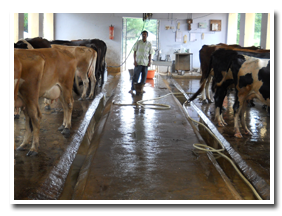 |
Disinfection |
- Disinfection means destruction of pathogenic micro organisms from a place so that the place becomes free from infection.
- Disinfectant, germicide, antiseptic is a substance able to kill organisms and their spores.
- Disinfection can be brought about with the help of physical, chemical and gaseous agents. Most disinfectants are chemical agents.
Types of disinfection
- Physical disinfectant
- Chemical disinfectant
- Gaseous disinfectants
Physical disinfectant
- Heat destroys microorganisms by denaturation of their cellular proteins through oxidation.
- Heat can be used in tow forms for sterilization dry and moist.
Dry heat
- Dry heat may be applied in the form of flame (300°C) to floors, walls and surface.
Moist heat
- Moist heat is far more effective than dry heat. It can be applied in the form of steam.
- Moist heat is more effective for disinfection of equipment, utensils etc.
Radiation
- The bactericidal effect of solar radiation due to the presence of ultraviolet rays in sunlight is a good disinfectant.
- Pathogens like Brucella are killed in 4-5 hours direct sun light exposure. Artificial UV lambs can also be sued for disinfection.
Filtration
- The technique has been used to control microbial population in air, water and biological materials.
Desiccation
- This process removes moisture from microorganisms, the drying effect varying with the type of microorganisms.
Chemical disinfectant
- These are very widely used in veterinary practice, as their aqueous solutions are easy to prepare.
- They are cheap and have a broad spectrum of activity.
- A good disinfectant neither stains nor damages materials.
- It is free of undesirable odours.
- Most of the commonly used disinfectants fall into one of the major categories mentioned below,
Acid and alkali
- Eg. Boric acid: 4-6%
- Sodium hydroxide (1,2 and 5%) is available as lye for disinfection of animal houses.
- Calcium hydroxide (lime water, slaked lime)
Aldehyde
- Formaldehyde (5-10%) can be used for washing floor of animal houses.
- Glutaraldehyde 2% aqueous solution is useful for sterilization of instruments.
Detergents and Soap
- These are used mainly for washing. They remove grease, dirt and Other organic matter, which tend to reduce the efficacy of disinfectants.
- Eg. Quarternary ammonium compounds; cetavlon; savlon
Halogens
- This important group of disinfectants finds wide use in veterinary and dairying practices.
- A process of oxidation following exposure to either chlorine or iodine brings about the destruction of pathogens.
- Gaseous chlorine, hypochlorite and organic chloramines are commonly used.
- Bleaching powder (calcium hypochlorite) is a commonly used disinfectant.
Metallic compounds
- Copper sulfate (5mg/lit) can be used.
Oxidizing agents
- Potassium permanganate (1-2mg/lit) can be used.
Phenols
- This group includes cresol (3-5%), Lysol(3-5%), thymol, tar acids and hexachlorophene.
- Phenol 0.5 to 5% can be used in veterinary practice.
Sodium carbonate
- 2.5-4% can be used for farm building
Bleaching powder (chlorinated lime)
- It is available in the form of white powder.
- 1 kg of bleaching powder can be used with 25 litres of water makes a very good deodorant.
Sodium hypochlorite
- It is similar to bleaching powder.
- It is a powerful germicide in the absence of organic matter.
Quick lime (calcium Oxide)
- Fresh lime is a good disinfectant.
- It is used in the burial pits to dispose the carcass and for land application.
Calcium hydroxide (slaked)
- Commonly used in white washing of the walls. It act as disinfectant also.
- While white washing 5% phenol can also be added for more effect.
Gaseous disinfectants are
- Formalin gas
- Ozone gas
- Cresol gas
|
|

| Quarantine |
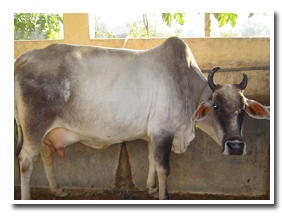 |
Quarantine |
- Quarantine is the process of segregating apparently healthy animals (especially animal being introduced into a herd or into the country for the first time) which have been exposed to the risk of infection.
- Quarantine period depends on the incubation period of diseases. In practice, a minimum period of 30 to 40 days has been generally accepted as the reasonable period; but in case of diseases like rabies this period is up to 6 months.
- Normally newly purchased animals and animals returned from show should be kept in the quarantine shed.
- The shed should be constructed at the entrance of the farm.
- They should be dipped or sprayed on the 25th / 26th day to remove the ectoparasites.
|
|

| Isolation |
- Isolation is the process of segregation of affected and in contact animals from the apparently healthy ones, in the event of outbreak of a contagious disease.
- Such segregated animals should preferably be housed in a separate isolation shed situated far away from the normal animal house.
- If a separate shed is not available the animals for isolation should be tied at one end of the shed as far away from the apparently healthy stock as possible.
- Attendants and equipment for sick animals should be ideally separate.
- If due to practical reasons this is not possible the sick animals should be attended only after the healthy stock.
- The equipment should be thoroughly disinfected after use in the isolation group.
- The attendant should wash his hands, feet and gumboots in antiseptic lotions and change his cloths.
- The isolated animals are brought back to the healthy herd only after they are fully recovered and the chance of passing on infection is removed.
|
|

| Deworming |
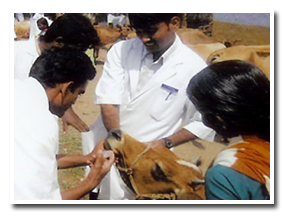 |
Deworming |
- Deworming should be started from the first week of calf.
- A single oral dose of 10 g piperazine adepate is recommended for the calves preferably in the first week of life to control neonatal ascariasis especially in buffalo calves.
- Deworming should be done every month for first 6 months, thereafter once in three months.
- The deworming drugs and dose should be consulted with qualified veterinary doctor.
- Over dose and under dose of deworming drugs should be prevented to check the side effects.
|
|

| Vaccination |
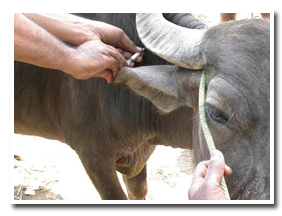 |
Vaccination |
- Vaccination of calves and adult animals is an essential practice to prevent the disease outbreak in farm animals.
- It should be started from the first four months of calf life.
- Anthrax, Brucellosis, Black Quarter, Hemorrhagic Septicemia and Foot and mouth Disease are the major diseases against which vaccination should be done for dairy animals.
- Vaccination should be perform by qualified veterinary doctor and should be done at proper season for a particular vaccine.
- While purchasing vaccine, expiry date should be checked and should keep the vaccine in ice cubes upto vaccination.
Vaccination schedule for calves
vaccine |
Age |
Foot and mouth |
2 to 4 months (first vaccination), 2 to 4 months after first vaccination, twice a year thereafter. |
Brucella |
4 to 8 months |
Black quarter( first vaccine) |
8 weeks before weaning |
Anthrax
Black quarter( 2nd vaccine)
Hemorrhagic septicemia |
6 months |
Vaccination schedule for adult animals
Vaccine |
Months |
Foot and mouth |
January to February |
Abortion causing brucellosis |
March to April |
Anthrax disease |
April to may |
Foot and mouth disease( twice a year) |
June to July |
Black quarter |
August to September( before monsoon) |
Hemorrhagic septicemia |
September to October |
|
|

| Isolation of sick animals |
 |
Isolation of Sick Animals |
- Isolation is the process of segregation of affected and in contact animals from the apparently healthy ones, in the event of outbreak of a contagious disease.
- Such segregated animals should preferably be housed in a separate isolation shed situated far away from the normal animal house.
- If a separate shed is not available the animals for isolation should be tied at one end of the shed as far away from the apparently healthy stock as possible.
- Attendants and equipment for sick animals should be ideally separate.
- If due to practical reasons this is not possible the sick animals should be attended only after the healthy stock.
- The equipment should be thoroughly disinfected after use in the isolation group.
- The attendant should wash his hands, feet and gumboots in antiseptic lotions and change his cloths.
- The isolated animals are brought back to the healthy herd only after they are fully recovered and the chance of passing on infection is removed.
|
|

| Proper time breeding of the animals |
- Animals exhibiting oestrus signs only should allow for breeding.
- Oestrus animals should be breed at their mid oestrus stage in order to get maximum conception rate.
- If oestrus signs observed in morning, breeding should be done in the evening.
- If oestrus signs observed in evening, breeding should be done in the next day morning.
- Breeding may be through matured disease free bull or artificial insemination.
- Artificial insemination should be done by qualified veterinary doctor in order to get efficient practice.
|
|

| Proper time pregnancy diagnosis |
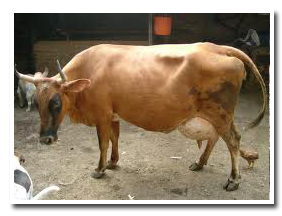 |
Proper Time Pregnancy diagnosis |
- Pregnancy diagnosis is essential; within 60-90 after breeding for confirm the pregnancy.
- This should be done by qualified veterinary doctor.
- This facilitates optimal feeding and care of pregnant animals in positive animals.
- This provides clear way to breed the animal in next oestrus in negative cases.
- Proper pregnancy diagnosis reduces the intercalving period and increases the production.
|
|

| Insuring the animals |
- It provides protection mechanism to the farmers and cattle rearers against any eventual loss of their animals due to death and to attaining qualitative improvement of livestock and their products.
- Farmers (small/ large/ marginal) and cattle rearers having the cross breed and high yielding cattle and buffaloes are the eligible beneficiaries.
- Covered risks are death of cattle due to accident inclusive of flood, cyclone, famine or any other fortuitous circumstances, diseases, surgical operations, riot, strike, terrorism and earthquake.
- Animals can be insured for maximum (100%) of their current market value.
- The General Insurance Corporation of India (GIC), New India Insurance and Oriental insurance are the major insurance companies providing cattle and buffalo insurance.
- For insuring animals, the farmers and animal owners first have to contact insurance agent / officer. Health certificat from a qualified veterinarian is required.
|
|

| Disposal and utilization of carcass |
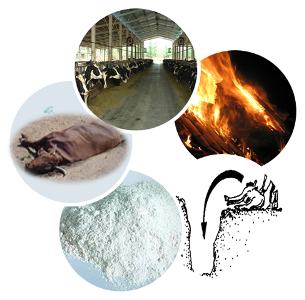 |
Disposal of Carcass |
- The primary purpose of safe disposal of carcass is to ensure the check and spread of disease either to other susceptible animals or humans.
- Carcasses of animals may be disposed of by sending them to knackeries or by burial or burning.
Burial of carcasses
- Burial a suitable site should be selected. The burial place must be distant from a well or water course and there is a sufficiency of subsoil to allow a depth of 6 feet above the carcass.
- The carcass must be buried in its skin, be covered with a sufficient quantity of quicklime or other disinfectants.
- The dead animals should be arranged upon its back with feet upwards.
- The skin is slashed inside the pit all cases except ;in the case of anthrax.
- As the small of carcass may attract foxes and dogs the area of the burial needs to be disinfect with coal tar which will act as detergent for sufficient length of time.
Incineration/cremation/burning of carcasses
- There are 4 methods of cremation
- Pit method
- Surface burning method
- Flame gun method
- Incineration in a destructor
Pit method
- Pit method for the carcass of a large cow dig a pit measuring about 7 feet long, 4 feet wide and 18 inch deep is dug.
- A trench about 9 inches wide and 9 inches deep is next dug right across the bottom of the pit, the ends of this cross trench being the bottom of the pit, and sloped upwards so as to reach ground level about 2.5 feet from the edge of the pit.
- The object of this trench is to provide for draught and to facilitate the lighting of the fire. The fire may be laid in the following sequence.
- Fill the trench with straw soaked with paraffin to provide lighting points.
- Place a few piece of heavy timber, iron rails at intervals across the ventilation trench so as to prevent its obstructions.
- Cover bottom of pit with thin pieces of wood.
- Add large pieces of wood.
- Saturate with paraffin.
- Add coal
- The fire is started by lighting the straw at one or both ends of the lighting points.
Surface burning method
- This method can usefully be adopted when labour is scarce or when the nature of ground is not suitable for construction of pit i.e., when the land is water logged.
- Two parallel trenches about 5 feet long, 9 inches wide and 9 inches deep and 2 feet apart are dug in the direction of the prevailing wind at the site selected for cremation.
- The carcass is placed over the trenches.
- Coal is placed on and around the carcass.
- Wood is soaked with paraffin.
- A small quantity of paraffin saturated straw is added, the fire is then lit.
Flame gun method
- No pit or trench is required in this method. The carcass is placed on ground or corrugated iron sheet and a powerful flame directed towards it, destroy the carcass.
- The time taken depends on the number of flame guns used and the size of the animals.
|
|

| Daily farm routine or day-to-day operation in an ideal dairy farm |
Time(hours) |
Farm Operations |
03.00-03.30 |
Cleaning/brushing of milch animals |
03.30-05.00 |
1.Feeding half of the daily concentrate ration just before milking
2.Milking cows |
05.00-05.30 |
1.Delivery of raw milk (in cans) to milk pick up van of dairy plants and receiving previous day’s empty cans
2.Washing and disinfection of milking barns |
05.30-08.00 |
1.Cleaning of milk cow sheds.
2.Feeding of dry/green fodder to milch stock
3.Cleaning of farm premises
4.Isolation of sick animals
5.Isolation of “in-heat” cows for artificial insemination
Note: use milkers at the rate of one for every 12-14 cows, for all the above operations. Milkers go off duty by 8 am and farm labour come on duty |
08.00-12.00 |
1.Cleaning calf, maternity, dry stock, bullock and bull sheds
2.Feeding half of the daily concentrate ration to calves, pregnant cows and bulls
3.Exercising and grooming of bulls
4.Treating sick animals.
5.Breeding cows that are “ in-heat”
6.Harvesting, chaffing and feeding of green fodder to all the stock.
Manger in all sheds should be filled with green fodder
Note: animals should be taken for grazing (if practiced) between 9 a.m and 2 p.m. in winter and between 6 a.m and 10 a.m. and again between 5 p.m. and 7 p.m. in summer |
12.00-13.00 |
Lunch cum rest period for labourers |
13.00-15.00 |
Miscellaneous jobs of dairy farm like stock identification, periodical vaccination, preparation of concentrate mixture, repair of farm fences, fitting and repair of equipments, rope and halter making, weekly scrubbing and white washing of drinking water tank, manure disposal/conservation, hay and silage making, periodical spraying of animal houses with suitable pesticides, periodical deworming of stock, clipping of hair from sides and hind quarters of cows; grooming, toe trimming, dehorning of calves, attending to sale and purchase of livestock and their transportation, fitting and training of cows for show.
Note: the dairy manager should planed the jobs well in advance in such a way that they are evenly distributed over the week. Some jobs may require longer time and the labour have to work extra time on such occasions. |
Milkers come duty by 14.30 hours and remain up to 1730 hours whereas general farm labour go off duty by 1700 hours. |
14.30-15.00 |
Washing/brushing of milch cows by milkers |
15.00-16.30 |
1.Feeding the other half of daily concentrate ration to milch cows just before milking
2.Milking
3.Cleaning calf, maternity, dry stock and bull sheds and feeding the other half of concentrate ration to calves, pregnant cows and bulls |
16.30-17.00 |
1. Delivery of milk (in cans) to milk pick-up vans of milk plants and collection of morning’s empty cans.
2.Washing and disinfection of milking barns
3.Feeding dry and green fodder to calves, dry stock and bulls |
17.00-18.30 |
1.Cleaning of milk cow shed.
2.Feeding green / dry fodder to milch stock
3.Cleaning of farm premises. |
18.30-03.00 |
Night watchman on duty |
|
|

| Registers to be maintained in a dairy farm |
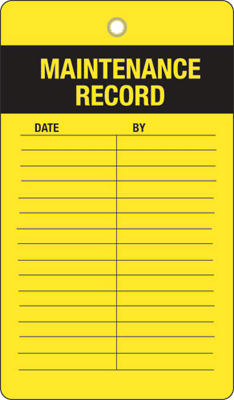 |
- Daily stock register
- Birth/calving register
- Calf / young stock register
- Adult stock register
- Breeding register/ AI register
- Weighment/ growth register
- Milk yield and distribution register
- Sales/ disposal register
- Mortality register
- Feed stock register
- Fodder stock register
- Receipt/ Income register
- Herd health register
|
| Record Maintenance |
Importance of record keeping
- The complicated job of management of a dairy herd requires sound planning for synchronization of all the inputs and all the factors that are chain linked to each other.
- It requires day to day planning, coordination, execution and evaluation, keeping in mind, the ultimate objective.
- This is possible only when the manager has all the facts pertaining to the stock before him. Such facts can be obtained from production and reproduction records.
On-herd uses of records
- Each animal in the herd is identified with respect to their production performance.
- Close management and appropriate feeding levels can be provided on the basis of production level.
- Efficiency of culling and selection has been increased which in turn will increase the profit rate.
- Relative influence of feeding, management and breeding can be assessed on production performance. >
- Livestock marketing can be promoted on the basis of performance records.
Off-herd uses of records
- Comparison of herd performance between and within breeds is possible.
- Superior stock can be identified for extensive use in breeding programmes.
- Herd and breed registration programmes can be implemented more effectively.
- Realistic research, development planning and plan implementation are possible.
- It should help the dairy manager / farmer to produce more quantity of milk at lower cost.
- It should provide required data to the administrators (for planning), research organizations (for processing and analyzing the enterprise scientifically), breeders (for formulating selection and breeding programmes) and extension personnel (for getting feedback information from the farmers).
|
|

| Common Vices of animals, their prevention and control |
- Vices are abnormal or bad habits shown by the animals.
1. Eye rolling
- The eyes are moved around in the orbit at a time when no visible object is present.
- Normally seen in calves confined in crates and stand immobile for extended period.
2. Tongue rolling
- The tongue is extruded from the moth and moved by curling and uncurling outside or inside the mouth with no solid material present.
- This condition occurs in all ages and breeds but young adult cattle and certain breeds such as Brown Swiss are exhibiting it most frequently.
- Factors responsible for these vices may be hereditary, continuous confinement, feeding of low roughages.
- Control method includes dietary inclusion of salt mixture, free movement.
3. Licking and eating own hair, wool
- Many young calves housed in individual crates, early weaning leads to licking those parts of their bodies which they can reach, this results in ingestion of large quantities of hair wic aggregates into hair balls or bezoars in the rumen.
- This vice is more common in calves moved from individual pen to group housing.
4. Sucking and eating solid objects
- Recently weaned calves will often suck and lick the walls, bars of their pen.
- This can be controlled by regular creosote paint of wood surface. Feeding good quality concentrate and roughage will minimize the incidence.
5. Intersucking by calves
- Calves separated from their mothers suck and lick at their own bodies, at objects in their pens and at parts of the bodies of other calves.
- The commonly suck on the navel, prepuce, scrotum, udder and ears of other animals.
6. Intersucking or milk sucking by adult animals
- This behavior involves a cow or bull sucking milk from the udder of a cow.
- Cattle suck milk from herd mates and choose the same lactating animal.
- This vice may lead to loss of milk yield and damage to teat.
- Proper feeding management and herd supervision can minimize such incidents.
|
|

|












